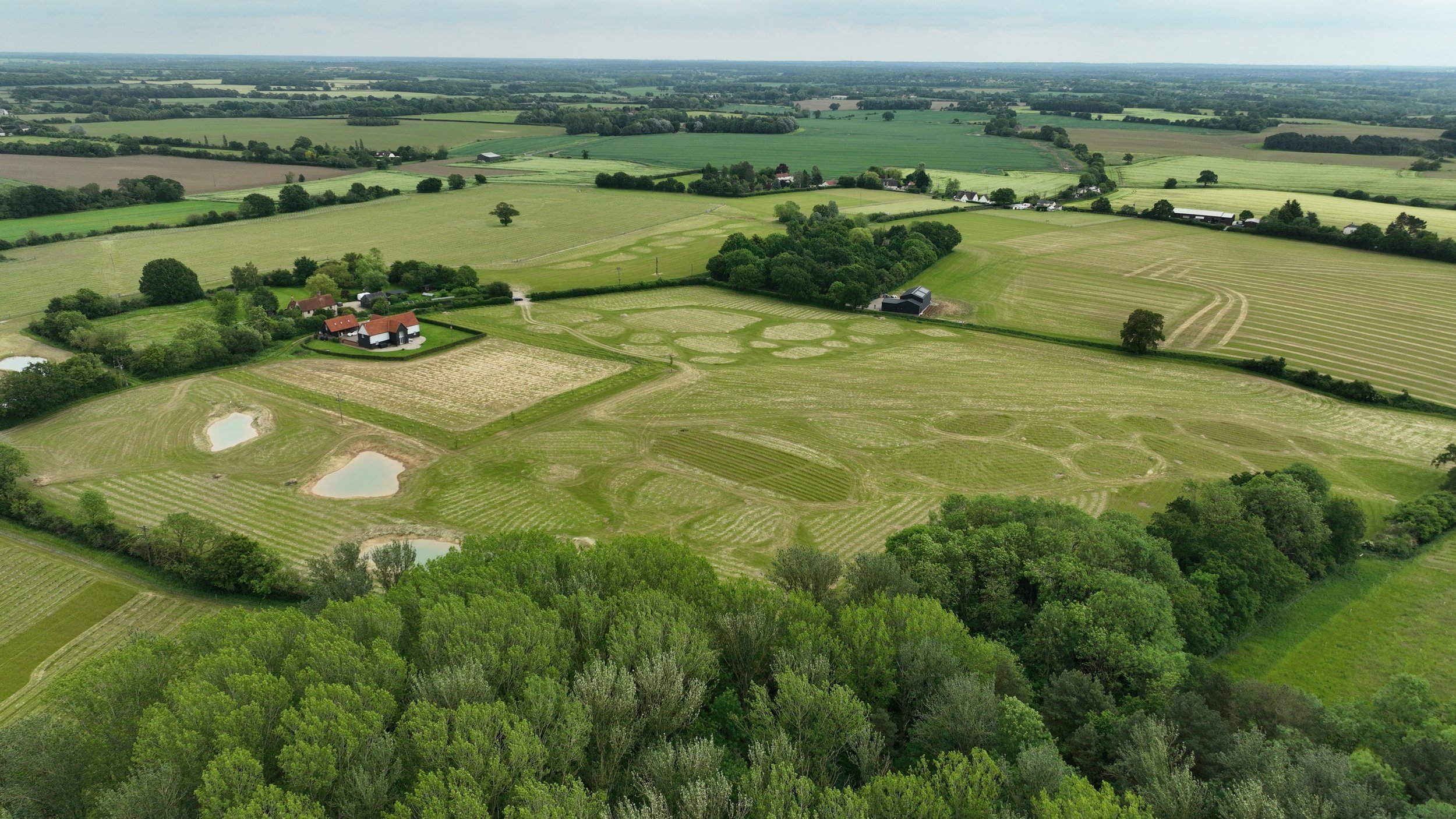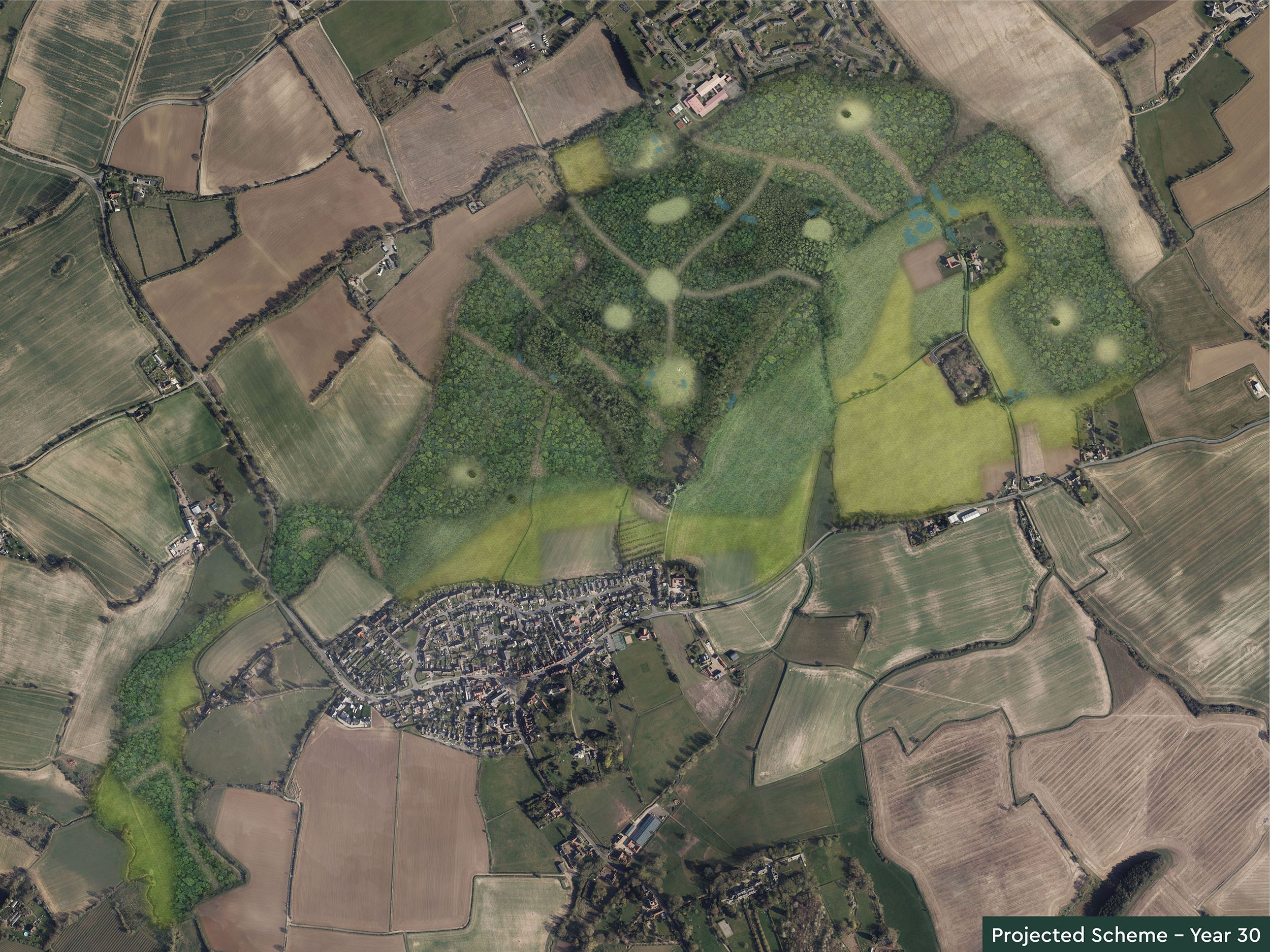The Wildfell Centre for Environmental Recovery
A 300-acre site for nature recovery in North Essex dedicated to creating habitat banks for biodiversity net gain and woodland creation
Launched in August 2021, the Evergreen Fund made a £2 million investment in a 296-acre estate in north Essex, near the village of Wethersfield in Braintree District.
The site was previously known as Gray’s Farm but has now been renamed The Wildfell Centre for Environmental Recovery. The estate includes a mix of arable land, woodland, and grassland. The River Pant flows nearby, feeding streams and several ponds on the estate.
Wildfell Centre is the biggest landscape-scale nature-recovery project that the Evergreen Fund has invested in to date. The transformation of this ex-arable farm is showcasing Biodiversity Net Gain and Carbon Sequestration design, delivery, and management innovation in action.
BNG units at Wildfell, Essex
Local Planning Authority: Braintree District Council
National Character Area: South Suffolk and North Essex Clayland
BNG Units: 383
Habitat units available
Grassland and other neutral grassland
Shrub and heath, mixed scrub
Woodland and forest and other mixed woodland
Hedgerow species: rich Hedgerow with trees
Grassland: traditional orchard
Lakes and ponds (non-priority)
Nature Recovery in Action
Working in partnership
We are collaborating with a diverse group of partners to test land management practices that boost biodiversity, increase habitats, and increase the nature recovery network connectivity.
The planting was completed in 2024
This included:
Completion of our woodland creation,
several kilometres of interconnecting hedgerows
Creation of our Biodiversity Net Gain (BNG) units across species-rich grassland, mixed scrub, lakes/ponds, traditional orchards, woodland enhancement, and hedgerow planting.
Wildfell barn
2024 also introduced the Wildfell Barn. This onsite facility aims to further our ambitions of using Wildfell to “act as an educational facility" and allowing clients and partners to join us for planting, BNG-focused activities, and to learn from our in-house experts.
The new barn has already hosted meetings and strategy days, and we have seen clients use the space to combine firsthand BNG experiences with policy creation.
The evolution of Wildfell
Spring 2021:
Grays Farm was purchased by Ground Control’s Evergreen Fund
We established an interface with nature, locating assets, operations, and activities (upstream and downstream) that interface with nature and biodiversity.
We established early community relations with Ground Control employees, Ground Control clients, The Forestry Commission, Essex Wildlife Trust, Essex County Council, Braintree District Council and Wethersfield Parish Council, residents of Wethersfield village, local businesses, and educational institutions
Summer 2021:
We assessed and identified the size and scale of impacts and dependencies on nature at each location, along with material risk mitigation and nature-related opportunities.
We set targets for creation, defined measurements, and developed policy, strategy, and action plans based on the results of the analysis.We investigated, scoped, and undertook surveys, assessments, and investigations to understand baseline ecological and biodiversity value and the context of the surroundings. This included a desktop study, a preliminary ecological appraisal, mapping, species-specific surveys, eDNA & DNA testing, botanical surveys, biodiversity metric calculations, soils and ground investigations, hydrology and water quality, and BioBlitz – an intensive 24-hour species survey.
Autumn 2021:
We carried out a habitat baseline study to enable measurement and reporting on the improvements that we make. This data has helped develop a habitat bank to generate income from the measured Biodiversity Net Gain will be delivered and calculated using the DEFRA metrics. This data was enhanced by species-specific surveys over the next 8 months to give further, detailed baseline data in addition to soil and water quality sampling.
We prepared studies, strategies, planned interventions, and management prescriptions to increase biodiversity, along with financing and permissions. This included habitat design, measurement and assessment, biodiversity action plans, management plans, nature recovery strategies, nature recovery modelling, grant funding and financing, option appraisals, financial tools and justification, planning, permitting and licensing, technical design and Engineering, S106 and conservation covenant advice.
Forestry Commission English Woodland Creation Offer submitted
Winter 2021:
The Biodiversity Net Gain scheme is designed
Stakeholder engagement happened across a wide range of local organisations, including local landowners, councils, Essex Wildlife Trust, RSPB, Bumblebee Conservation Trust, Plantlife, Dragonfly Trust, Farming & Wildlife Action Group East, Environment Agency, Royal Botanic Gardens Kew, and the Forestry Commission. This helped inform the design using the best local knowledge and experience, along with developing ongoing partnerships for the future management and monitoring of the site.
The first planting took place to mark COP2, creating ‘First Avenue’. Twenty-six native trees were planted, each dedicated to a UK Environmental Hero – a diverse group of leading environmentalists and unsung green champions taking pioneering action to tackle climate change and reverse nature’s decline
5000 native trees and shrubs were planted in partnership with Briggs Equipment. Made possible by Evergreen Fund investment, the intervention enhanced a 1,000m section of native hedgerow to allow the site boundary. We selected 21 different native species to increase biodiversity and strengthen connectivity with existing hedges and trees.
Spring 2022:
Ecologists carried out surveys for great crested newts, bats, breeding birds, hazel dormice, reptiles, and BAP mammals. The reptile information we gathered over the following few months allowed us to form a picture of the populations on site, including where their home ranges are and whether these species are breeding. Such insights informed potential habitat enhancements, including the provision of hibernacula and management prescriptions for the habitats.
We began an innovative partnership between Ground Control’s Wildfell, Plant Life, Royal Botanic Gardens Kew, and the Bumblebee Conservation Trust. We collaborated by putting plants, fungi, and pollinators at the heart of a project. This 'super group' delivers surveys and scientific research and provides a mechanism for capturing valuable input into habitat creation and management proposals.
Wildfell was established as a Carbon Observatory with partners CSX Carbon. Initial terrestrial laser-scanned plots were completed in the established woodland and hedgerows. LIDAR and Optical data were collected using advanced drone technology. The data was processed to give highly detailed models of above-ground biomass and carbon stocks. This is monitored over time to measure the positive impacts of our project.
DEFRA Metric baseline calculations were completed as part of proposals for a Habitat Management Plan to deliver Biodiversity Units. A fundamental objective of the project is to maximise the Biodiversity Net Gain of the land we now own and manage.
We established a partnership with the Environment Agency, which will fund tree planting and explore opportunities to carry out ground modeling in the River Pant corridor and the wider catchment.
Summer 2022:
We completed ecology reports and celebrated the discovery of seven species of bat (including Barbastelle and Natterers - relatively scarce species in Essex), Great Crested Newt, Common Lizard, Grass Snake, forty-seven species of bird (including one Red Kite) and active nesting Owl, Raven, Mallard, Moorhen, and Starling. We were also excited to capture our first Otter on the banks of the River Pant, four active Badger sets, Hare, Rabbit, Fox, and Grey Squirrel.
We also captured a Mink on camera. Minks are an invasive, non-native species that harm native fauna, especially the water vole. We work with Essex Wildlife Trust to support their mink control project.
We have identified the Rare Bee and the Early Purple Orchids.
We completed our Bio Bank design and management proposals
We secured funding for five new Great Crested Newt ponds through Natural England and FWAG East.
We began a formal Pollinator Collaboration with Royal Botanic Gardens Kew and the Bumblebee Conservation Trust; through the collaboration, our partners survey erected bee boxes and monitor solitary bees.
Autumn 2022:
We hosted a visit from the Forestry Commission Board at Wildfell and Ground Control’s South Essex nature-recovery site Little Cowbridge Wood.
Forestry Commission English Woodland Creation Offer is approved
Works began on the planned Wildfell Learning Centre (Wildfell Barn). An access track and temporary compound are created to provide an accessible location for welfare, material, and plant storage while a permanent building and yard are constructed. The access track is constructed with a no-dig makeup to avoid any impact on the roots of adjacent trees
We welcome the Lower Thames Crossing (LTC) senior leadership team and key stakeholders to Wildfell. The tour of the site showcased the pioneering woodland, meadow, hedgerow, and pond restoration programmes that were underway.
We continue to share biodiversity expertise and key learnings from Wildfell to help LTC take away a deeper understanding of how it can achieve Hole Farm’s ambitions.
We commenced a Mulch Mat effectiveness pilot. This was the first time mulch mats had been tested at scale. The pilot was carried out across 50ha of new native woodland (approx. 100,000 trees).
Winter 2022:
Completion of phase 1 woodland creation: 46,925 native trees and shrubs have been planted and protected with vole guards and mulch mats. This includes 22 tree species and 12 shrub species.
1,275m of native hedgerow was planted to create wildlife corridors to reconnect ecological features on the site boundaries.
The first phase of conversion from arable fields to species-rich grassland is establishing well, with everything on track for the first spring cut.
The new ponds filled up substantially over the winter period ready for biodiverse wetlands to establish.Further ecological surveys, with the baseline reporting making good progress.
Summer 2023
Wildfell was Highly Commended at the Unlock Net Zero awards in the Biodiversity and Nature category.
Spring 2024
Aiming to further our ambitions of using Wildfell to “act as an educational facility" and allowing clients and partners to join us for planting, BNG-focused activities, and to learn from our in-house experts, our new on-site hub and eucation centre known as the Wildfell Barn opened.
The new barn has already hosted meetings and strategy days, and we have seen clients use the space to combine firsthand BNG experiences with policy creation
Autumn / Winter 2024
Completion of our woodland creation, several kilometres of interconnecting hedgerows, and the creation of our Biodiversity Net Gain (BNG) units across species-rich grassland, mixed scrub, lakes/ponds, traditional orchards, woodland enhancement, and hedgerow planting.
In 2024, the key focus of these was:
Planting 1.5 km of native hedgerows
Restoring and enhancing 15 acres of woodland
Completing 3 establishment cuts of species-rich grassland
Establishing woodland, scrub, and orchard
Completing phase 1 replacement planting
Contributing locally with £20,000 local spend
Year 1 ecological monitoring for habitat creation completed
Year 3 drone survey completed
Over 250 volunteering days and visits completed by clients, Ground Control teams, partners, and the community.
Wildfell was awarded Excellence in Biodiversity Conservation and Enhancement at the Essex Housing Awards and formed a large part of the submissions to Ground Control, winning Sustainable Company of the Year at the Pro Landscaper Awards, and being Highly Commended for Environmental Impact at the VINCI Facilities Supply Chain Awards .
Summer 2025
Wildfell secures a landmark Conservation Covenant (ConCov) approval, with wildlife charity Plantlife acting as the official Responsible Body. This formal legal agreement enables the sale of Biodiversity Net Gain (BNG) units at Wildfell Habitat Bank in Essex, ensuring adherence to the highest standards of ecological integrity and legal compliance.
Wildfell, alongside Devana, achieves certification under Plantlife’s Standard for Biodiversity Improvement. This standard must be recertified annually for a minimum of 30 years, ensuring robust, long-term quality assurance for potential buyers.
-

Wildfell wins Excellence in Biodiversity Conservation and Enhancement
Ground Control’s Wildfell Centre for Environmental Recovery has won the “Excellence in Biodiversity Conservation and Enhancement” award at the 2024 Essex Housing Awards.
-

How hedgerows contribute to Biodiversity Net Gain (BNG)
Celebrating the secret powers of hedgerows for National Hedgerow Week 2025
-

The first full year at Devana
Chris Bawtree, Ground Control Nature Recovery Director and Evergreen Board member shares highlights from the first full year of Devana, our BNG habitat bank in South Cambridgeshire



















